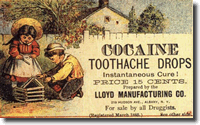About Cocaine
- What is Cocaine
- Effects of Cocaine
- Who Uses Cocaine
- Cocaine Statistics
- Cocaine Information
- Facts About Cocaine
- Dangers of Cocaine Use
- Signs of Cocaine Use
- About Cocaine
- Stages of Cocaine Addiction
- Cocaine Withdrawal
- Cocaine Overdose
- Cocaine Treatment
- Snorting Cocaine
- Smoking Cocaine
- Injecting Cocaine
- Crack Cocaine
- Using Cocaine with Alcohol
- Cost of Cocaine
- Cocaine Side Effects
- Cocaine Street Names
- Drug Tests for Cocaine
- History of Cocaine
- Cocaine User Pictures
- Cocaine Images

History of Cocaine
 The history of cocaine shows that it is contained in small amounts in the leaves of several species of the erythroxylum (coca) bush, which grow on the slopes of the Andes Mountains in South America. For at least 4,500 years, people in Peru and Bolivia have chewed coca leaves to lessen hunger and fatigue. Today, most of the world's supply of coca is grown and refined into cocaine in Colombia. Criminal networks control the lucrative cocaine trade.
The history of cocaine shows that it is contained in small amounts in the leaves of several species of the erythroxylum (coca) bush, which grow on the slopes of the Andes Mountains in South America. For at least 4,500 years, people in Peru and Bolivia have chewed coca leaves to lessen hunger and fatigue. Today, most of the world's supply of coca is grown and refined into cocaine in Colombia. Criminal networks control the lucrative cocaine trade.
What does cocaine look like and how is it used? Cocaine hydrochloride, the form in which cocaine is snorted or injected is a white crystalline powder. It is sometimes "cut," or mixed, with things that look like it, such as cornstarch or talcum powder, or with other drugs, such as local anesthetics or amphetamines. Powder cocaine can be chemically changed to create forms of cocaine that can be smoked. These forms, known as "freebase" and "crack," look like crystals or rocks. Cocaine is often used with other drugs, especially alcohol and marijuana. Cocaine and heroin, mixed and dissolved for injection, is called a "speedball."
During the history of cocaine, a cocaine epidemic swept through the nation during the 1980s and may now be subsiding, leaving in its wake large numbers of people with long-term dependencies. Drug use in general, and the problems associated with it, are still at very high levels by historic standards, and the street violence surrounding drug trafficking may yet grow worse over the next several years, especially in the inner city. However, available indicators of drug use show that both initiation rates and the total number of people using drugs are declining.
The composition of the drug-using population has also begun to change. The data indicate that the sharpest reductions in drug use have occurred in suburban areas and among the educated middle class: It is likely that changing attitudes (e.g., increasing concern about the dangers of drug use and decreasing social approval) rather than enforcement efforts have influenced occasional users to quit using drugs.
Unfortunately, over the last decade the history of cocaine shows that this drug has become cheaper, more readily available, and more addictive in the smokable form of "crack," it appears that both poor and criminal segments of the population, especially in the inner cities, began to use the drug more heavily. As a result, these people now represent a larger share of the drug-using population. The data also point to an increasingly strong association between cocaine use and health problems, and cocaine use and crime. This in part may explain why, in the face of declining drug use, we may see continued or even increasing drug-related health problems and violence in the inner cities. Below we describe more on the history of cocaine and some of the apparent changes in the trends and composition of the cocaine-using population over the last decade.
The History of Cocaine: National Surveys of Drug Use
The history of cocaine notes that the most widely reported measures of drug use are provided by two national surveys funded by the National Institute on Drug Abuse (NIDA): the High School Senior Survey (HSSS), conducted annually by the University of Michigan; and the periodic National Household Survey on Drug Abuse (NHSDA), which reports on drug use in the general population. The weaknesses of the surveys are well known, but they are not likely to distort general trends. For example, the surveys exclude populations known to be rich in drug users: The HSSS does not include school dropouts, and the NHSDA excludes institutional populations (such as those in prison) and the homeless. The surveys also rely on the willingness of individuals to report disapproved behavior. Since approval of drug use has declined over the last decade, it is likely that the willingness to report such use has also declined. Thus, one cannot use the data to estimate the number of heavy drug users, and the trends may be less sharp than they appear in the surveys. However, the trendlines certainly point in the correct direction.
The history of cocaine shows that after a steep rise in the late 1970s, drug use in general (dominated by marijuana use) declined sharply. For cocaine, the pattern is somewhat more complicated. Cocaine use rose from about 2 percent in 1975 to nearly 6 percent in 1979, where it remained except for a sharp peak in 1985 (6.7 percent). From 1985 to 1991, usage declined steadily to 1.4 percent. The history of cocaine shows a similar pattern in the NHSDA for 18-25 year olds, the age group with the highest drug-use rates. Marijuana use rose sharply in the late 1970s and then fell throughout the 1980s. For cocaine, use increased in the late 1970s, then leveled off and did not begin to reverse until the mid-1980s.
As noted above, it appears that the driving force behind these trends has been an increasing awareness of the dangers of drug use and a growing sense of social disapproval. Certainly, decreased availability is not a factor. The proportion of HSSS respondents reporting marijuana as readily available or available has been around 85 percent every year. As for the history of cocaine, perceived availability rose from 46 percent in 1979 to 59 percent in 1989, before falling to 51 percent in 1991.
